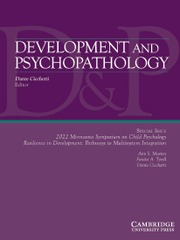No CrossRef data available.
Article contents
Developmental trajectories of externalizing and internalizing linked to harsh parenting: The role of ethnicity and socioeconomic status
Published online by Cambridge University Press: 02 May 2025
Abstract
Past studies that examined externalizing and internalizing symptoms in separate samples have found different trajectories associated with harsh parenting. The present study uses a complex set of longitudinal modeling to investigate the developmental trajectories of internalizing and externalizing symptoms associated with harsh parenting. We also explore the moderation of socioeconomic status and ethnicity by testing differences between income and racial groups. Using bivariate and multigroup latent change score modeling, we analyzed 12,909 participants from the Millennium Cohort Study. Results of the bivariate latent change score model showed that harsh parenting had a bidirectional association with externalizing symptoms but only a unidirectional association with internalizing symptoms. A further analysis using multi-group modeling showed that the association between harsh parenting and externalizing and internalizing symptoms differed across ethnic backgrounds but much less on socioeconomic status. Specifically, initial levels of harsh parenting predicted an increase in externalizing symptoms among White participants but not in non-White participants, and these ethnic differences cut across socioeconomic status classifications in a test of the interaction of ethnicity and socioeconomic status. Taken together, our findings suggest that the prevailing cultural norms surrounding harsh parenting may affect the degree to which it negatively impacts children’s mental health.
Information
- Type
- Regular Article
- Information
- Copyright
- © The Author(s), 2025. Published by Cambridge University Press


